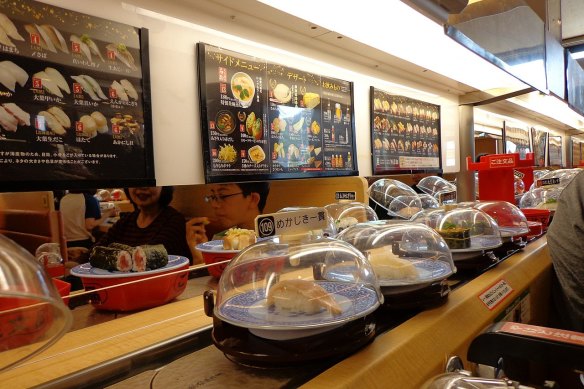No joke, Japanese police arrest three over ‘sushi terrorism’ incident

Tokyo: Most people would agree that drinking out of a restaurant’s communal soy sauce bottle is disgusting. But is it criminal?
It’s a question that may soon go before Japanese courts after the police arrested three people linked to a viral video of a young man showing little regard for hygiene in one of the country’s popular conveyor belt sushi shops.
Inside a sushi conveyor belt restaurant in Japan.Credit:Savannah Rivka/CC/Wikicommons
Called “sushi terrorism” by some, the stunt is one of several that have lit up Japanese social media in recent months, provoking a national wave of revulsion and a panicked reaction from some of the country’s largest sushi chains, which worried about the impact on sales.
In the video that motivated the arrests, a young man with bleach-blond hair grabs sushi off a conveyor belt and devours it. He then upends a bottle of soy sauce into his mouth.
Alerted to the video by the restaurant’s management company, Japanese authorities sprang into action. On February 5, two days after the video appeared online, the police collared the 19-year-old man who had posted it. They took his two “conspirators” — a 15-year-old girl and the 21-year-old soy sipper — into custody Wednesday.
In a statement on Thursday, the police in Nagoya, an industrial city in central Japan, said they were holding the three on suspicion of “forcible obstruction of business.” The charge carries a maximum penalty of three years in prison.
Posting the video constituted an act of “force,” the police said, adding that the restaurant’s management company had to field compensation claims from customers and do a thorough cleaning, making it “difficult to conduct normal business”.
“Sushi terrorism” videos first began drawing attention online in early January. Revulsion built over the following weeks as a handful of copycats filmed themselves engaged in antics like licking a cup available to other diners.
For Japan’s thousands of conveyor belt sushi restaurants, the videos were no joke. Operators say the posts have created a public relations crisis as customers fret about sanitation.
In a typical conveyor belt setup, an array of sushi glides around the restaurant, passing in easy reach of diners who grab what they want to eat. When it’s time to pay the bill, a server tallies up the empty plates; different colours represent different prices.
In response to the videos, several popular chains have made changes in an effort to soothe customers’ concerns. For some, like the discount chain Sushiro, that means customers now have to order their sushi directly from a touch screen, rather than plucking dishes off the conveyor belt.
Kura Sushi, the chain where the soy sauce incident occurred, said it was aiming for an even more high-tech solution: using artificial intelligence to monitor customers for suspicious behaviour.
A spokesperson said that an existing network of cameras installed at tables to automatically calculate customer’s bills would be updated to keep an eye on their actions as well. The company hopes to restore trust, he said, after customers said they were afraid to eat at its restaurants.
It’s not the first time that viral posts on the internet have provoked soul-searching about the state of the national character. In the early 2010s, Japanese social media boiled over after a series of photos appeared online showing people engaged in a variety of off-putting pranks like eating directly from a container for serving customers or squeezing into an ice cream freezer at a convenience store.
But arrests are unusual. On social media Thursday, commentators largely praised the police’s actions, expressing hope that they would dissuade imitators. Others questioned whether it was appropriate to arrest people for what amounted to a disgusting prank.
Kenichi Tamura, a lawyer representing the man in the video, said the incident was an attempt to receive “social approval and validation” by a troubled young person who had not fully considered the consequences of his actions.
There were some indications that the police might continue hauling in sushi terrorists.
Tetsuya Yamamoto, a spokesperson for Hama Sushi, said the company had approached authorities about two videos recorded at its restaurants. The first showed a man dumping wasabi on a plate of sushi as it passed by him. In the other, a man used a chopstick to spear a piece of sushi from a plate without taking it off the belt first.
The perpetrators offered an apology, but the company “politely refused,” Yamamoto said.
For the behaviour to stop, he said, there needs to be “a common understanding that it’s a crime”.
For now, he added, “we’re waiting for the police to make their move”.
This article originally appeared in The New York Times.
Get a note directly from our foreign correspondents on what’s making headlines around the world. Sign up for the weekly What in the World newsletter here.
Most Viewed in World
From our partners
Source: Read Full Article
